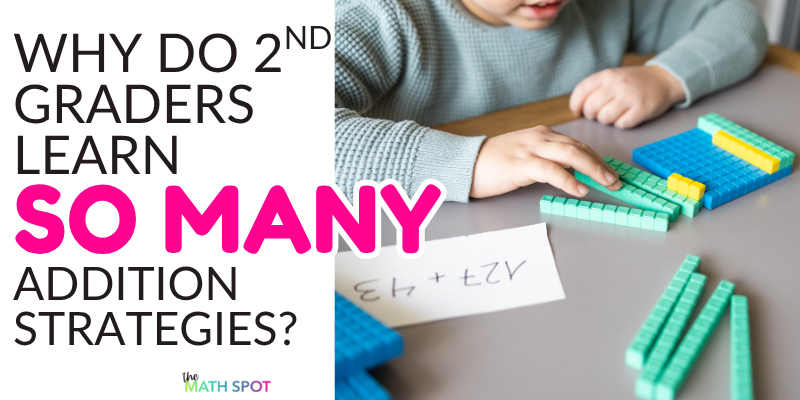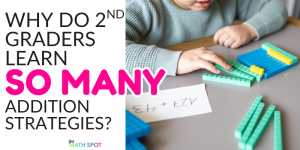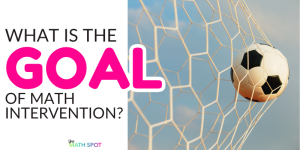This post contains affiliate links. This means that when you make a purchase, at no additional cost to you, I will earn a small commission.
One of the most common questions about second grade math is why students are asked to learn so many different addition strategies. At first glance, it can feel random and overwhelming but there is actually a very intentional progression happening.

Second graders are working across two strands, Operations and Algebraic Thinking (OA) and Number and Operations in Base Ten (NBT). When you understand the differences between these strands and pay attention to what the standards are asking, the strategies begin to make sense. They aren’t just extra methods or tricks and we certainly are not just hunting for the strategy that “clicks” for each student. Each strategy is tied directly to the standards and to the fluency goals we are building for students.
Starting the Year: Related Facts and Mental Strategies
At the beginning of the year, many second graders are working within OA standards such as:
- 2.OA.B.2: Fluently add and subtract within 20 using mental strategies. By end of Grade 2, know from memory all sums of two one-digit numbers.
This work builds on the Level 3 strategies from first grade, where students use related facts and flexible thinking. When you see students decomposing numbers, making tens, or thinking addition to solve subtraction, this is exactly what the standards are asking for.
These mental strategies are not “extra” or “cute tricks.” They are the pathway to fluency asking students to solve facts quickly, accurately, and flexibly.
In my 2nd grade curriculum I strategically begin with a unit on Addition and Subtraction to 20 Strategies (this accounts for level 1 & 2 strategies as a review) and then moves into Addition and Subtraction to 20 Relationships (this is the level 3 “related facts” work that allows students to exercise flexibility to quickly solve addition and subtraction facts.
Where the Internet Loses Its Mind
After students build fluency with facts within 20, the next step in second grade is learning to add and subtract within 100. This is outlined in 2.NBT.B.5: Fluently add and subtract within 100 using strategies based on place value, properties of operations, and the relationship between addition and subtraction.
This is the moment where I often hear pushback: “Why don’t kids just line up the numbers and add?”
Here’s why. At this stage, students are working in the NBT strand. The expectation is not simply to calculate but rather to apply what they know about place value and benchmark numbers to solve problems fluently. The word fluently at the start of this standard is critical. Fluency means quickly, accurately, and flexibly. Depending on the problem, one strategy may be more efficient than another.
The multiple strategies aren’t about finding the one that “clicks” for a struggling student. They exist because the standard itself requires students to demonstrate flexibility in how they apply place value and number relationships to addition and subtraction.
In my second grade curriculum, this plays out across three different units:
1. Decomposing Strategies
This is the idea that you can mentally break apart numbers into tens and ones to make them easier to work with. For example, 52 + 41 can be thought of as (50 + 40) + (2 + 1). On paper, it looks bulky, and this is often where the internet loses its mind. But we aren’t stopping at this written form; it’s simply a step in the CRA progression. Students start concretely with base ten blocks, then move to drawing quick tens and ones, and finally can hold the decomposition mentally. The notation is just a scaffold along the way to mental math, not the end goal.
2. Number Line Strategies
Number lines give students a visual way to work flexibly with addition and subtraction, especially when problems cross a ten or would traditionally require “unbundling.” For example, solving 72 – 25 might look like hopping back 20 (72 → 52), then subtracting 2 more to get to 50, and subtracting the final 3 to land at 47. On paper, it might look a little clunky, but remember — paper is not the final goal. Number lines provide a stepping stone that makes otherwise abstract reasoning more concrete and manageable for students.
3. Related Fact Strategies
These strategies lean on what students already know to make new problems easier. Examples include:
- Adding by finding a ten (9 + 7 → think 10 + 6) and expanding this to larger numbers (29 + 7 -> think 30 + 6)
- Subtracting by using a nearby decade number (52 – 19 → think 52 – 20 + 1)
- Using compensation to adjust numbers into friendlier facts (36 + 29 → think 36 + 30 – 1)
These related fact strategies help students see the structure of our number system and build powerful mental shortcuts they can use across different problems.
Each of these units might look messy on paper, but they are never meant to stay there. They are carefully designed progressions that move students from concrete, to representational, to abstract reasoning. Together, they build the mental flexibility and efficiency that students need long before they’re ready for the algorithm.
Shifting Into Place Value Work
After this work with mental strategies, the focus shifts toward larger numbers and we have a change in the NBT standard.
2.NBT.B.7: Add and subtract within 1000, using concrete models or drawings and strategies based on place value, properties of operations, and the relationship between addition and subtraction.
Notice the difference. Now, students are extending their number knowledge so they can apply place value-based strategies. They are no longer just working mentally within 100. They are beginning to operate with larger numbers, and the standard calls for concrete models and drawings rather than asking for fluency.
Where the Algorithm Fits
By the end of second grade, the standard algorithm is not required by the standards. But in practice, it often begins to appear in tier 1 instruction.
So yes, the kids will eventually stack the numbers. But they will also have had the chance to develop number sense and mental flexibility first which is exactly what we want if we are truly building fluency.
The Big Picture
There is a clear progression that really is both smart and strategic. It gives students the chance to:
- Build mental fluency and ultimately memory with facts up to 20.
- Develop flexibility with a range of mental strategies for problems up to 100.
- Apply place value knowledge to add and subtract numbers using written strategies for problems up to 1,000.
This progression is not about teaching “too many strategies.” It is about giving students the strategies they need to be fluent, flexible, and confident with a variety of different numbers.



